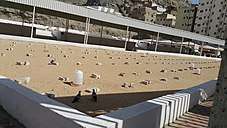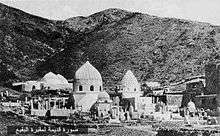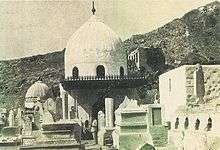Jannat al-Mu'alla
Jannat al-Mu'alla (Arabic: جَنَّة ٱلْمُعَلَّاة, romanized: Jannah al-Muʿallāh, lit. 'The Most Exalted Paradise'), also known as the Cemetery of Ma'la[1] (Arabic: مَقْبَرَة ٱلْمَعْلَاة Maqbarah al-Maʿlāh) and Al-Hajun (Arabic: ٱلْحَجُون), is a cemetery to the north of the Masjid al-Haram, and near the Mosque of the Jinn, in Makkah, Saudi Arabia. It is the place where Muhammad's wife, grandfather, and other ancestors are buried.
 Jannat al-Mu'alla cemetery | |
| Details | |
|---|---|
| Established | Pre-Islamic |
| Location | |
| Country | Saudi Arabia |
| Type | Muslim |
| Owned by | Islam |
| No. of graves | Abu Talib, Khadija (wife of Muhammad), Abdul Mutalib the grandfather of Muhammad. |
History

Many of Muhammad's relatives were buried in this cemetery before his Hegira in 622. Many domes and structures have been built or rebuilt over famous graves over the years.[2]

Tombs in this cemetery were demolished in 1925, the same year that the Jannat al-Baqi' cemetery in Medina was demolished by Saudi King, Ibn Saud. This happened despite protests by the international Islamic community.[3] Some Shiites continue to mourn the day the House of Saud demolished shrines in al-Baqi, which has been named yaum e gham or "Day of Sorrow". Shiites continue to protest the Saudi government's demolition of these shrines.
Notable interments
Famous historical figures buried here include:
- Abu Talib ibn Abdul-Muttalib, uncle of Muhammad and father of Ali
- Abd Manaf, great-great-grandfather of Muhammad
- Abdul Mutallib, grandfather of Muhammad
- Khadija, first wife of Muhammad and mother of their progeny (also the first person to accept Islam)
- Abu Turab al-Zahiri, 20th-century Muslim cleric
- Muhammad Alawi al-Maliki, 20th-century Sunni Muslim cleric
See also
- Jannat al-Baqi'
- Bab Saghir
- Holiest sites in Sunni Islam
- Holiest sites in Shia Islam
- Holiest sites in Sufi Islam
References
- Tütüncü, Mehmet (2015). "The Uppsala Makkah Painting: A New Source for the Cultural Topography and Historiography for Mecca". In Buitelaar, Marjo; Mols, Luitgard (eds.). Hajj: Global Interactions through Pilgrimage. Leiden: Sidestone Press. pp. 137–163. ISBN 978-90-8890-285-7.
- "History of JANNAT AL-MAULLA". Retrieved 26 August 2015.
- "History of the cemetery of Jannat al-Baqi". Retrieved 26 August 2015.